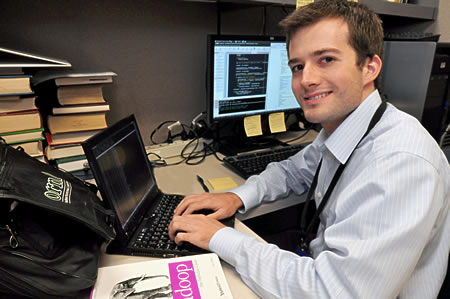
Christopher Tomkins-Tinch
Intern leverages data to support rapid response to biological threats

Christopher Tomkins-Tinch’s research conducted at Oak Ridge National Laboratory’s Undergraduate Co-op program could help the U.S. government fight biological weapons of mass destruction. Click image to enlarge.
In his spare time, Christopher Tomkins-Tinch is a do-it-yourselfer, who likes to take things apart.
This past summer, he gained knowledge to help him put together the pieces of the complex puzzle called bioinformatics.
Tomkins-Tinch participated in the Undergraduate Student Cooperative Education Program at Oak Ridge National Laboratory. This isn’t the Rochester Institute of Technology student's first learning stint with ORNL. Previously, he spent four quarters, including two summers, with the organization.
Bioinformatics is the science of developing computer databases and algorithms for biological research. It is mostly used in human genome research, which includes the study of genetics and DNA. The genomic information is essential to understanding diseases. It is also crucial to the identification of new molecular targets for pharmaceutical research.
Asked about pivotal research in the field, Tomkins-Tinch noted that “the first complete human genomic sequence was published in 2003, the result of a multi-billion-dollar, decade-long effort of researchers from around the globe. This is really something, because in a few years we will be able to sequence anyone's genome for a few thousand dollars.
“The ‘holy grail’ is the $1,000 personal genomic sequence. When that happens, we may see medicine personalized for each patient. We may see bioinformatics touch many aspects of our lives,” he explained.
With Mallikarjun Shankar, Ph.D., as a mentor, Tomkins-Tinch worked on a research project for the Defense Threat Reduction Agency, which is part of the U.S. Department of Defense. Its function is to protect the country and its interests from weapons of mass destruction: chemical, biological, radiological, nuclear and high explosives.
The focus of the project was to facilitate bioinformatics data sharing and storage for rapid-turnaround pathogen (an infectious agent or germ) identification.
“The hope is that it my project will be a component of a larger data infrastructure that will allow bioinformaticists, biotechnologists and pharmaceutical researchers to identify and quickly develop medical countermeasures for an unknown pathogen,” he said.
After he completes his undergraduate and graduate studies at RIT, Tomkins-Tinch aspires to enroll in a doctoral program to study information science, bioinformatics, or computer science. After doctoral work, he hopes to work as part of a research group.
“Ideally at a place like ORNL,” Tomkins-Tinch said. “Academics are great, but I like more applied work, too.”
With is co-op experience in hand, Tomkins-Tinch’s research drive is in high gear.
“I have greatly enjoyed this,” he said. “I have grown as an individual and a scholar as a result of my experience at the lab. Only good things can happen when everyone around you is bright and interested.”